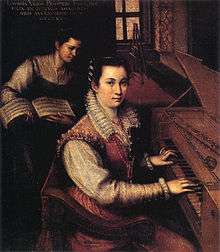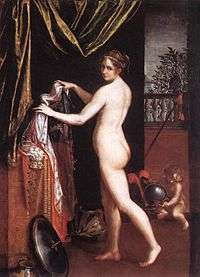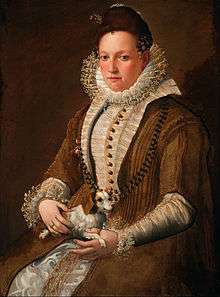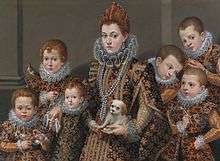Lavinia Fontana


Lavinia Fontana (August 24, 1552 – August 11, 1614) was an Italian painter. She is regarded as the first woman artist, working within the same sphere as her male counterparts, outside a court or convent.[1] She was the first woman artist to paint female nudes, and possibly the first female to use live nude female models.[2] She was the main breadwinner of a family of 13.[3]
Biography


Lavinia Fontana was born in Bologna, the daughter of the painter Prospero Fontana, who was a prominent painter of the School of Bologna at the time and served as her teacher. Continuing the family business was typical at the time.
Her earliest known work, "Monkey Child", was painted in 1575 at the age of 23. Though this work is now lost, another early painting, Christ with the Symbols of the Passion, painted in 1576, is now in the El Paso Museum of Art.[4] She would go on to paint in a variety of genres. Early in her career, she was most famous for painting upper-class residents of her native Bologna, notably noblewomen. Even as her gender may have hindered her career in a society less accustomed to female artists, it may have made women more comfortable sitting for her. Her relationships with female clients were often unusually warm; multiple women who sat for portraits painted by Fontana, such as the Duchess of Sora Constanza Sforza Boncompagni, later served as namesakes or godmothers for her children.[5] She began her commercial practice by painting small devotional paintings on copper, which had popular appeal as papal and diplomatic gifts, given the value and lustre of the metal.[6] In addition to portraits (the typical subject matter for women painters[7]), she later created large scale paintings with religious and mythological themes which sometimes included female nudes.[1] Fontana married Paolo Zappi (alternately spelled Paolo Fappi) in 1577. She gave birth to 11 children, though only 3 outlived her. After marriage, Fontana continued to paint to support her family. Zappi took care of the household and served as painting assistant to his wife, including painting minor elements of paintings like draperies. Fontana attended the University of Bologna, and completed a degree in 1580.[8]

Fontana and her family moved to Rome in 1603 at the invitation of Pope Clement VIII. She gained the patronage of the Buoncompagni, of which Pope Gregory XIII was a member. Lavinia thrived in Rome as she had in Bologna and Pope Paul V himself was among her sitters. She was the recipient of numerous honors,[1] including a bronze portrait medallion cast in 1611 by sculptor and architect Felice Antonio Casoni.[9]
Some of her portraits, often lavishly paid for, have been wrongly attributed to Guido Reni. Chief among these are Venus; The Virgin lifting a veil from the sleeping infant Christ; and the Queen of Sheba visiting Solomon. Her self-portrait – in youth she was said to have been very beautiful – was perhaps her masterpiece; it belongs to Count Zappi of Imola, the family into which Lavinia married. Fontana's self-portraiture strikes a balance between presenting the artist as a distinguished lady and as a professional artist. This depiction of two coexisting roles was common for sixteenth-century women artists.[10]
While her youthful style was much like her father's, she gradually adopted the Carracciesque style, with strong quasi-Venetian coloring. She was elected into the Accademia di San Luca of Rome, and died in that city on August 11, 1614.
There are over 100 works that are documented, but only 32 signed and dated works are known today. There are 25 more that can be attributed to her, making hers the largest oeuvre for any female artist prior to 1700. Sofonisba Anguissola may have been an influence on her career.
Major works
- Self-Portrait with the Spinet Accompanied by a Handmaiden (1577) – Accademia Nazionale di San Luca, Rome
- Consecration to the Virgin, – Musee des Beaux-Arts, Marseilles, originally the Gnetti Chapel, Santa Maria dei Servi, Bologna
- Self-Portrait with Palette and Brushes, 1579.
- Portrait of a Lady with Lap Dog (c. 1595) – Walters Art Museum, Baltimore
- Portrait of Gerolamo Mercuriale (c. 1587–1590) – Walters Art Museum, Baltimore
- Portrait of a Noblewoman (ca. 1580) – National Museum of Women in the Arts, Washington
- Noli me tangere (1581) – Uffizi, Florence
- Assumption of the Virgin with Saints Peter Chrysologus, and Cassian (1584) – Palazzo Comunale, Imola
- Portrait of the Gozzadini Family (1584) – Pinacoteca Nazionale, Bologna
- Holy Family (1589) – El Escorial, Outside Madrid
- Birth of Virgin – Santissima Trinità, Bologna
- Portrait of a Couple (1580–1585) – Cleveland Museum of Art, Cleveland
- The Dead Christ with Symbols (1581) – Cornell Fine Arts Museum,[4] Winter Park, Florida
- Jesus among the Doctors – Part of the Mysteries of the Rosary in the Rosary chapel in the Basilica of San Domenico, Bologna
See also
| Wikimedia Commons has media related to Lavinia Fontana. |
Notes
- 1 2 3 "Artist Profile: Lavinia Fontana". National Museum of Women in the Arts. Retrieved 29 March 2013.
- ↑ De Girolami Cheney, Liana (2015). "Lavinia Fontana's nude Minervas". Woman's Art Journal.: 30–40. ISSN 0270-7993. OCLC 956553105.
- ↑ Weidemann, Christiane; Larass, Petra; Melanie, Klier (2008). 50 Women Artists You Should Know. Prestel. pp. 18, 19. ISBN 978-3-7913-3956-6.
- 1 2 "Cornell Fine Arts Museum, Collection Overview". Rollins College. Retrieved 22 February 2014.
- ↑ Murphy, Caroline P. (1996-01-01). "Lavinia Fontana and "Le Dame della Città": understanding female artistic patronage in late sixteenth-century Bologna". Renaissance Studies. 10 (2): 190–208. JSTOR 24412268.
- ↑ Murphy, Caroline P. (2003). Lavinia Fontana: A Painter and Her Patrons in Sixteenth-century Bologna. Yale University Press. p. 30. ISBN 978-0-300-09913-3.
- ↑ Bayer, Andrea; The Metropolitan Museum of Art (New York) (2003). North of the Apennines: sixteenth-century Italian painting in Lombardy and Emilia-Romagna. New York, NY: Metropolitan Museum of Art. p. 47. OCLC 907098674.
- ↑ "Brooklyn Museum: Lavinia Fontana". www.brooklynmuseum.org. Retrieved 2018-03-08.
- ↑ "Lavinia Fontana, 1552-1614, Bolognese Painter by Felice Antonio Casone". National Gallery of Art. Retrieved 29 March 2013.
- ↑ Frances Borzello, Seeing Ourselves: Women's Self-Portraiture 1998
References
- Chadwick, Whitney (1990). Women, Art, and Society. London: Thames and Hudson.
- Findlen, Paula (2002-11-08). The Italian Renaissance. ISBN 978-0-631-22283-5.
- Gaze, Delia. Concise Dictionary of Women Artists.
- Harris, Anne Sutherland; Nochlin, Linda (1976). Women Artists: 1550-1950. New York: Los Angeles County Museum of Art.
- Smyth, Francis P.; O'Neill, John P. (1986). The Age of Correggio and the Carracci: Emilian Painting of the 16th and 17th Centuries. Washington DC: National Gallery of Art. pp. 132–136.
- Murphy, Caroline P. (2003). Lavinia Fontana: A Painter and Her Patrons in Sixteenth-century Bologna. Yale University Press. p. 30. ISBN 978-0-300-09913-3.
- Hansen, Morten Steen; Spicer, Joaneath, eds. (2005). Masterpieces of Italian Painting, The Walters Art Museum. Baltimore and London. ISBN 978-1904832140.
- Attribution

Further reading
- Fortunati, Vera (1998). Lavinia Fontana of Bologna (1552–1614). Milan: Electa. ISBN 978-8843563944.
- Niyazi, Hazan. "Lavinia Fontana and the female self-portrait". Retrieved 29 March 2013.
- Wasserman, Krystyna (2011-11-10). "Curator's Travelogue: Women Artists of Bologna". National Museum of Women in the Arts. Retrieved 29 March 2013.
External links

- Orazio and Artemisia Gentileschi, a fully digitized exhibition catalog from The Metropolitan Museum of Art Libraries, which contains material on Lavinia Fontana (see index)